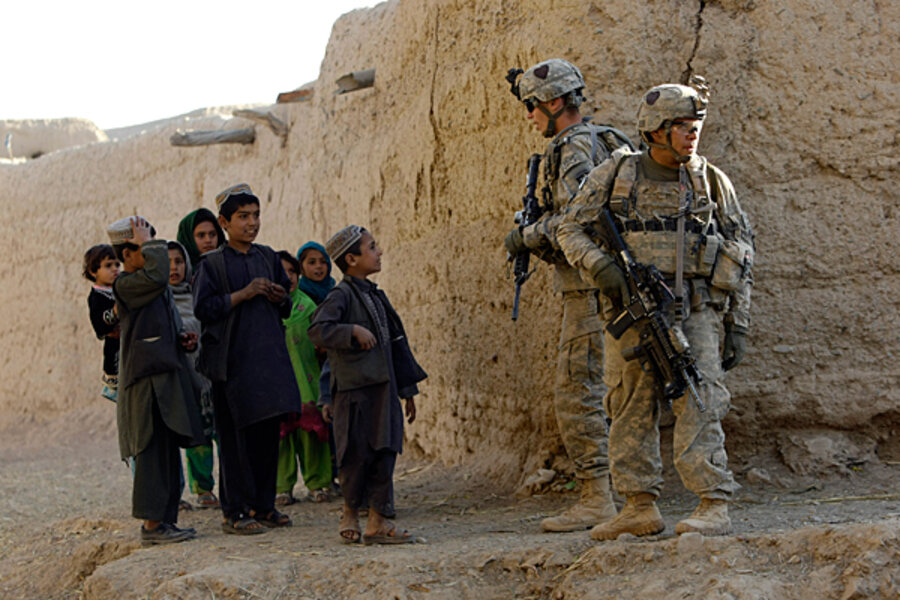War in Afghanistan: Pentagon report cites 'progress,' provides little
Loading...
| Washington
The Pentagon's semiannual report to Congress on the war in Afghanistan paints a picture of a country where corruption remains rampant, violence has increased, and a well-funded Taliban insurgency continues to make troubling gains.
The report, “Progress Toward Security and Stability in Afghanistan,” which was released this week, actually cites little in the way of progress in the war, a major US undertaking that is rapidly losing popular support among Americans and threatens to become a political burden on President Obama.
The number of Afghans rating their security situation as “bad” is “the highest since the nationwide survey began in September 2008,” the report’s authors write, noting that the “downward trend in security perception is likely due to the steady increase in total violence over the past nine months.”
The rise in violence, however, was an anticipated outcome of the ramped up US military operations in the country, the Pentagon says.
A senior defense official who briefed reporters on the findings Tuesday afternoon said the violence is “exactly what we expected. It’s what we predicted.” It is the result, he says, of an influx of US troops into the country – a US presence that is now at an all-time high of some 100,000 military personnel – running headlong into an active insurgency.
According to the report, the Taliban insurgency’s capabilities and operational reach “have been qualitatively and geographically expanding” with plentiful sources of funding.
Iran, meanwhile, often cited by US commanders as a catalyst for violence in Iraq at the height of the insurgency there, has not sought to expand its influence in Afghanistan, according to the report. While the country continues to provide “small arms, ammunition, RPGs, and materials used to create IEDs,” or improvised explosive devices, intelligence from the past year “indicates neither a significant increase in Iranian support, nor the provision of more advanced Iranian signature weaponry.”
Rampant corruption remains a concern for US officials. According to the report, 80 percent of Afghans believe that corruption impacts their daily lives. “This is consistent with the view that corruption is preventing the Afghan government from connecting with the people and remains a key reason for Afghans supporting the insurgency,” says the report.
Much of that corruption, senior defense officials concede, is the result of US-funded contractors, who may inadvertently be funneling money to the Taliban. “A lot of what we’re doing is, when we talk about the issue of corruption and enabling people, we need to look in the mirror first and see what we’re doing,” said the senior defense official.
This is a complicated prospect, he added. So, too, is the training of Afghan security forces, though it was one of the rare upbeat points in the Pentagon report. As of September, growth in the Afghan army and police force “are among Afghanistan’s most promising areas of progress.”
Attrition, however, remains a problem, as does a shortage of NATO trainers – a shortage “that will grow more acute through the fall and into next year, if troop contributions do not meet the growing need for training.… This shortfall poses significant strategic risk and threatens to delay the upcoming transition process.”
Even as the Obama administration steps away from July 2011 as a departure date of any consequence for US troops, senior officials in the briefing this week were reluctant to discuss the 2014 date that was put forward by Afghan President Hamid Karzai as a new goal for US combat troops to leave the country.
When asked by a reporter about the US “exit strategy” for Afghanistan, the senior defense official took issue with the term. “We don’t have an exit strategy. We have a transition strategy. The US commitment to Afghanistan is continuing, enduring, and long-lasting.”
The reporter suggested a rephrasing: “How about the exit of combat troops?”
Countered a senior State Department official, “How about the transition to Afghan control?”
It is clear that any such transition depends on progress in the country. The latest nationwide survey, cited in the report, finds that “48 percent of Afghans polled said that Afghanistan is heading in the right direction.”
What is left unsaid in the report is that the other half of the country does not – and that remains the ongoing challenge for US commanders on the ground.





